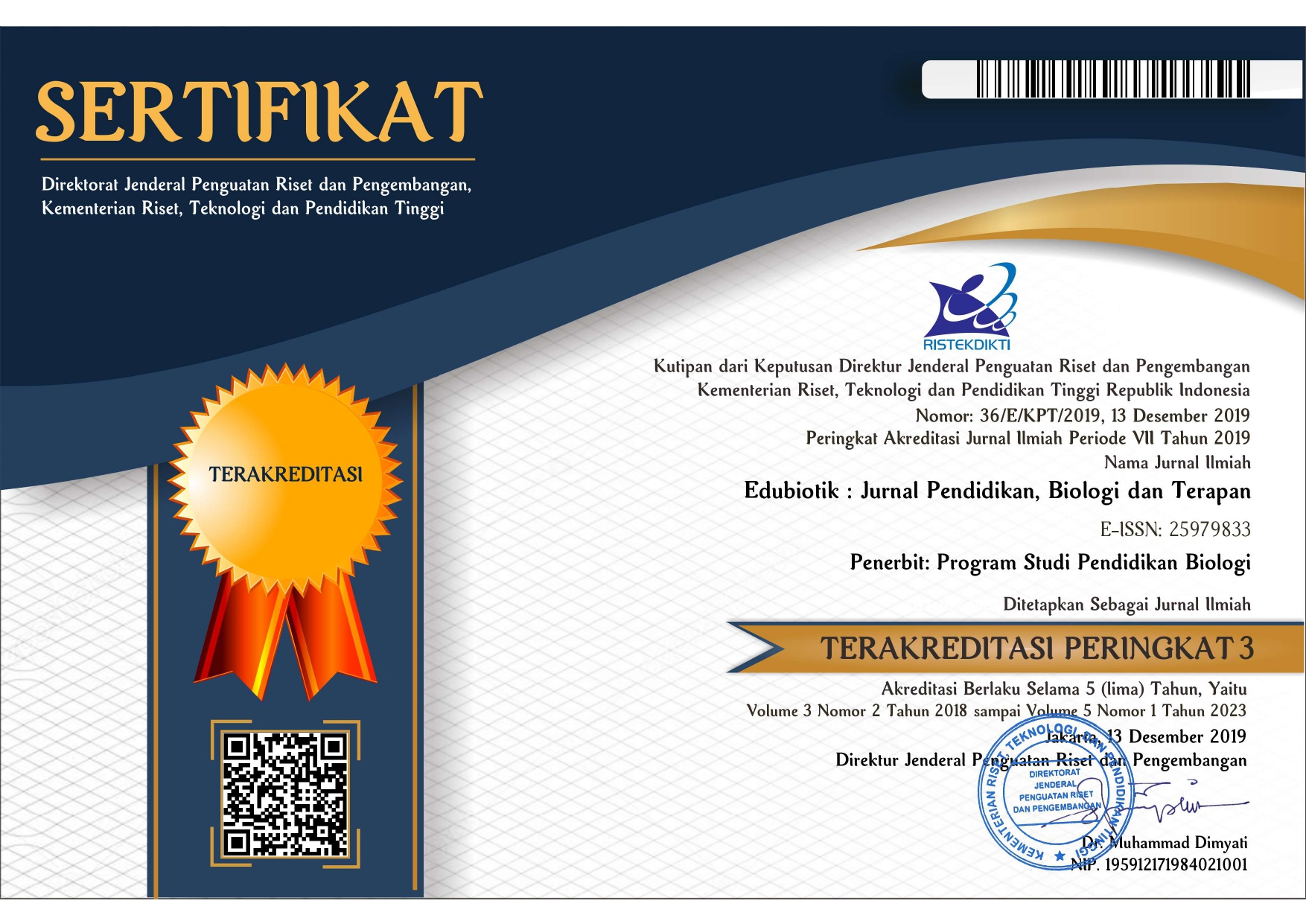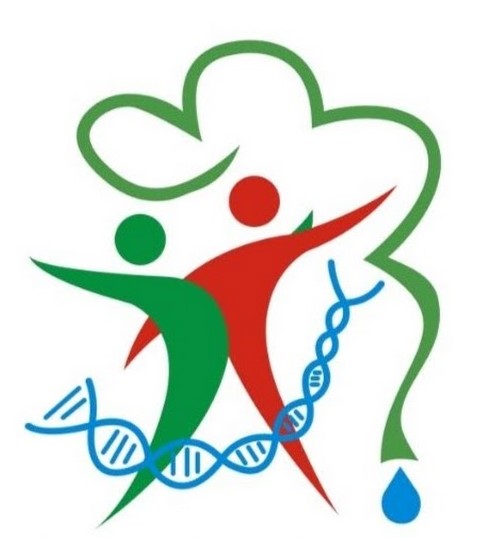Molecular characterization of genus Tor from Indonesia based on 16S rRNA
Abstract
Genus Tor is Indonesia's endangered local fish however, the reports on this species from South East Asia is currently limited. This study conducted to characterize molecular genetics and phylogenetic relationship of Tor fish from East Java, West Kalimantan, Padang and North Sumatra from BPBAT Bogor collection using a partial sequence of mtDNA 16S rRNA. A total of ten samples of Genus Tor were collected, then identified based on morphological characters, and the identification was confirmed using molecular data. PCR amplicons at 542 bp in length. The construction of phylogenetic topology was made based on ML and NJ method using Kimura-2 parameter model. Based on the phylogenetic topology showed that Tor fish from Pasuruan are closely related to Tor duoronensis from Padang with a bootstrap value of 66%, while Tor duoronensis fish from North Sumatra and Tor tambra from West Kalimantan are in separated clusters. This finding also contributes to the differentiate Genus Tor from Indonesia based on polymorphic sites.
References
Dudu, A., Georgescu, S. E., Popa, O., Dinischiotu, A., & Costache, M. (2011). Mitochondrial 16S and 12S rRNA sequence analysis in four salmonid species from romania. Acta Zoologica Academiae Scientiarum Hungaricae, 57(3), 233–246. https://www.sid.ir/en/journal/ViewPaper.aspx?ID=406663
Eprilurahman, R., Simarmata, A. K., Hakim, L., & Trijoko, T. (2021). Morphological and molecular characters of Cherax quadricarinatus (von Martens, 1868) from Sermo Reservoir and Tambakboyo Retention Basin, Daerah Istimewa Yogyakarta, Indonesia. Biogenesis: Jurnal Ilmiah Biologi, 9(1), 18. https://doi.org/10.24252/bio.v9i1.16612
Esa, Y., & Abdul Rahim, K. A. (2013). Genetic structure and preliminary findings of cryptic diversity of the Malaysian mahseer (Tor tambroides valenciennes: Cyprinidae) inferred from mitochondrial DNA and microsatellite analyses. BioMed Research International, 2013. https://doi.org/10.1155/2013/170980
Eschmeyer, W., Fricke, R., Laan, R. Van Der, & Utrecht, H. (2016). Catalog of Fishes : Genera , Species , References. June. https://www.calacademy.org/scientists/projects/eschmeyers-catalog-of-fishes
Folmer, O., Black, M., Hoeh, W., Lutz, R., & Vrijenhoek, R. (1994). DNA primers for amplification of mitochondrial cytochrome c oxidase subunit I from diverse metazoan invertebrates. Molecular marine biology and biotechnology, 3(5), 294–299. https://doi.org/10.1071/ZO9660275
Glon, M. G., Thoma, R. F., Taylor, C. A., Daly, M., & Freudenstein, J. V. (2018). Molecular phylogenetic analysis of the devil crayfish group, with elevation of Lacunicambarus Hobbs, 1969 to generic rank and a redescription of the devil crayfish, Lacunicambarus diogenes (Girard, 1852) comb. Nov. (Decapoda: Astacoidea: Cambaridae). Journal of Crustacean Biology, 38(5), 600–613. https://doi.org/10.1093/jcbiol/ruy057
Haryono & Tjakrawidjaja, A. . (2006). Morphological Study for Identification Improvement of Tambra Fish (Tor spp.: Cyprinidae) from Indonesia. Biodiversitas Journal of Biological Diversity, 7(1), 59–62. https://doi.org/10.13057/biodiv/d070115
Juniar, A. E., Ambarwati, R., & Rahayu, D. A. (2021). Genetic identification of clithon oualaniense (Gastropoda: Neritidae) from Madura, Indonesia. AACL Bioflux, 14(2), 1046–1056. http://www.bioflux.com.ro/docs/2021.1046-1056.pdf
Kottelat, M., & Whitten, A. J. (1994). Freshwater Fishes of Western Indonesia and Sulawesi. Copeia, 1994(3), 830. https://doi.org/10.2307/1447208
Listyorini, D., Winaris, N., Prananingrum, P., Kartikasari, N., Rahayu, D. A., Khasna, E. N., & Kahrisma, V. D. (2011). Biologi Molekuler. https://erlangga.co.id/
Maralit, B. A., Aguila, R. D., Ventolero, M. F. H., Perez, S. K. L., Willette, D. A., & Santos, M. D. (2013). Detection of mislabeled commercial fishery by-products in the Philippines using DNA barcodes and its implications to food traceability and safety. Food Control, 33(1), 119–125. https://doi.org/10.1016/j.foodcont.2013.02.018
Martins, S., Simões, F., Mendonça, D., Matos, J., Silva, A. P., & Carnide, V. (2013). Median-joining networks for inferring intraspecific phylogenies. Genetic resources and crop evolution, 60(4), 37–48. https://doi.org/10.1007/978-94-009-1207-6_2
Mikkelsen, N. T., Schander, C., & Willassen, E. (2007). Local scale DNA barcoding of bivalves (Mollusca): A case study. Zoologica Scripta, 36(5), 455–463. https://doi.org/10.1111/j.1463-6409.2006.00289.x
Nguyen, T. T. T., Ingram, B., Sungan, S., Gooley, G., Sim, S. Y., Tinggi, D., & De Silva, S. S. (2006). Mitochondrial DNA diversity of broodstock of two indigenous mahseer species, Tor tambroides and T. douronensis (Cyprinidae) cultured in Sarawak, Malaysia. Aquaculture, 253(1–4), 259–269. https://doi.org/10.1016/j.aquaculture.2005.09.014
Nguyen, T. T. T., Na-Nakorn, U., Sukmanomon, S., & ZiMing, C. (2008). A study on phylogeny and biogeography of mahseer species (Pisces: Cyprinidae) using sequences of three mitochondrial DNA gene regions. Molecular Phylogenetics and Evolution, 48(3), 1223–1231. https://doi.org/10.1016/j.ympev.2008.01.006
Nugroho, ED & Rahayu, D. (2015). Status taksonomi ikan nomei dari perairan tarakan, kalimantan utara berdasarkan gen. Jurnal Harpodon Borneo, 8(2002), 132–141. https://doi.org/10.35334/harpodon.v8i2.134
Popa, L. O., Popa, O. P., Gargarea, P., & Murariu, D. (2007). Sequence analysis of the 5’ COI gene region from Dama dama (Linnaeus, 1758) (Mammalia : Cervidae). Travaux du Museum National d’Histoire Naturelle Grigore Antipa, 50, 537–542. https://eurekamag.com/research/021/737/021737344.php
Priyono, D. S., Solihin, D. D., Farajallah, A., & Arini, D. I. D. (2018). Anoa, dwarf buffalo from sulawesi, indonesia: Identification based on dna barcode. Biodiversitas, 19(6), 1985–1992. https://doi.org/10.13057/biodiv/d190602
Rahayu, DA., Nugroho, ED., Azrianingsih, R., Kurniawan, N., H. (2016). Morphometric Analysis of Local Fish from Banyu Biru Lake, Pasuruan Compared with Closely Related to Tor spp. from Indonesia. Journal of Tropical Life Science, 3(3), 156–159. https://doi.org/10.11594/jtls.03.03.03
Rahayu, DA & Nugroho, E. (2014). Pendekatan Fenetik Taksonomi Dalam Identifikasi Kekerabatan Dan Pengelompokkan Ikan Genus Tor Di Indonesia. Bioedukasi, 7(1), 60–64. https://jurnal.uns.ac.id/bioedukasi/article/view/2844
Rahayu, D. A., & Jannah, M. (2019). DNA Barcode Hewan dan Tumbuhan Indonesia. 65, 1–20. https://osf.io/ty7e5/
Roberts, T. R. (1999). Fishes of the cyprinid genus Tor in the Nam Theun watershed (Mekong Basin) of Laos, with description of a new species. Raffles Bulletin of Zoology, 47(1), 225–236. https://research.si.edu/publication-details/?id=73115
Rozas, J. R. and R. (1995). DnaSP, DNA sequence polymorphism: Computer Applications in the Biosciences, 11(September), 621–625. https://europepmc.org/article/med/8808578
Sari, S. Y. P., Ambarwati, R., & Rahayu, D. A. (2021). Molecular characteristics of Donax faba (Bivalvia: Donacidae) from Nepa Beach, Madura, based on cytochrome oxidase subunit I gene sequences. AACL Bioflux, 14(4), 2416–2426. http://bioflux.com.ro/
Sharma, U., Gupta, D. P., & Mohanty, P. S. (2014). Phylogenetic analysis among Cyprinidae family using 16SrRNA. International Journal of Fisheries and Aquatic Studies, 1(6), 66–71. https://www.fisheriesjournal.com/
Skuza, L., Keszka, S., Panicz, R., & Smietana, P. (2016). Molecular characterization of the noble crayfish (Astacus astacus L.) population from Pomeranian lakes (north-western Poland) based on mitochondrial DNA. Knowledge and Management of Aquatic Ecosystems, 2016-Janua(417), 4–9. https://doi.org/10.1051/kmae/2015046
Tamura, K., Stecher, G., Peterson, D., Filipski, A., & Kumar, S. (2013). MEGA6: Molecular evolutionary genetics analysis version 6.0. Molecular Biology and Evolution, 30(12), 2725–2729. https://doi.org/10.1093/molbev/mst197
Voris, H. K. (2000). Maps of Pleistocene sea levels in Southeast Asia: Shorelines, river systems and time durations. Journal of Biogeography, 27(5), 1153–1167. https://doi.org/10.1046/j.1365-2699.2000.00489.x
Wallace, D. C., & Chalkia, D. (2013). Mitochondrial DNA genetics and the heteroplasmy conundrum in evolution and disease. Cold Spring Harbor perspectives in medicine, 3(10), 1–47. https://pubmed.ncbi.nlm.nih.gov/24186072/
Weber, M., & Beaufor, L. F. De. (1916). The fishes of the Indo-Australian Archipelago. Brill, Leiden, The Netherlands. https://www.biodiversitylibrary.org/item/46027#page/13/mode/1up
Wong, E. H. K., & Hanner, R. H. (2008). DNA barcoding detects market substitution in North American seafood. Food Research International, 41(8), 828–837. https://doi.org/10.1016/j.foodres.2008.07.005
Yang, S., Lai, X., Sheng, G., & Wang, S. (2013). Deep genetic divergence within a “living fossil” brachiopod Lingula anatina . Journal of Paleontology, 87(5), 902–908. https://doi.org/10.1666/12-127





.png)
2.png)

1.jpg)


